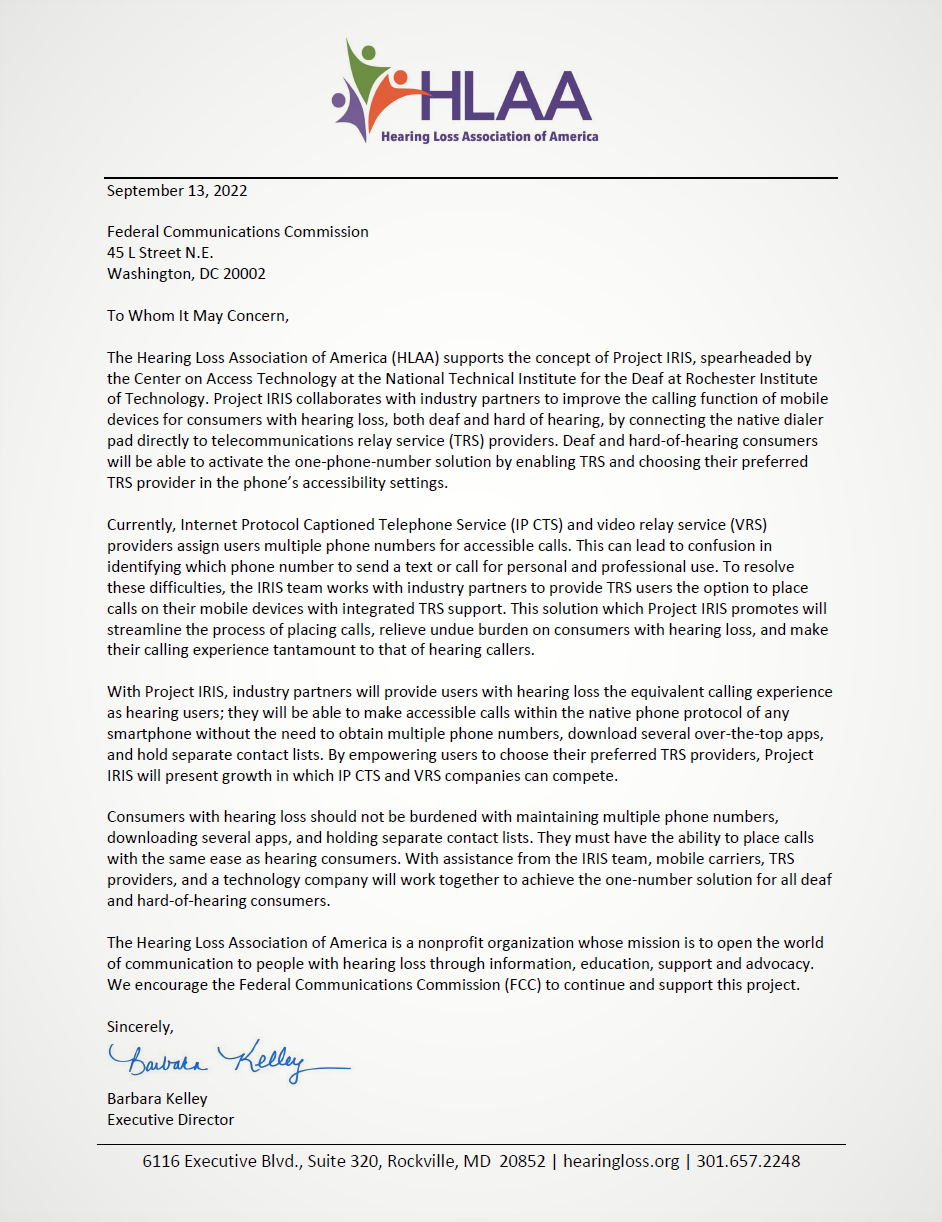

September 2022: The Hearing Loss Association of America (HLAA) sent a letter to the Federal Communications Commission (FCC), cementing their support of Project IRIS and encouraging potential industry partners to participate in this project. The letter recognizes the shortcomings of the current system and expounds how Project IRIS will mitigate these issues while meeting the needs of people with hearing loss and providing efficient communication for TRS users. Furthermore, it states that the IRIS team is working with industry partners in integrating the system in mobile devices and also that Project IRIS will foster competition amongst TRS companies by allowing the consumers to choose the best TRS providers for their needs. You can read the letter here: HLAA’s letter
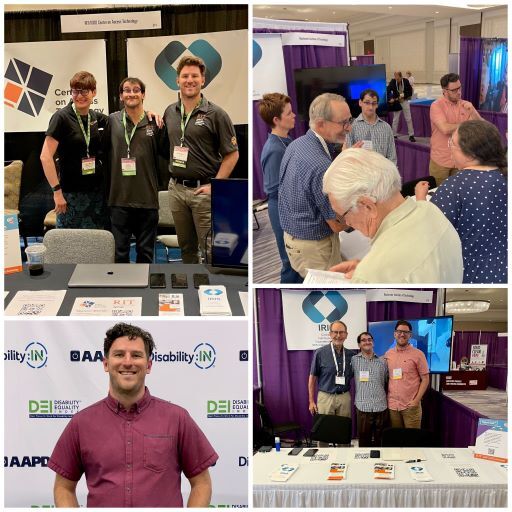
August 2022: The Center on Access Technology traveled to Florida and Texas for conferences hosted by the Hearing Loss Association of America (HLAA), the National Association of the Deaf (NAD), and Disability:In. CAT formed new partnerships with telecommunications relay service companies, telecommunications companies, technology companies, and more in realizing the goal for equivalent communication access for deaf and hard-of-hearing people. It was also the first time Project IRIS has been demonstrated successfully outside of a laboratory in front of people unfamiliar with the project. If you are interested in supporting Project IRIS, please take a moment to fill out this form.
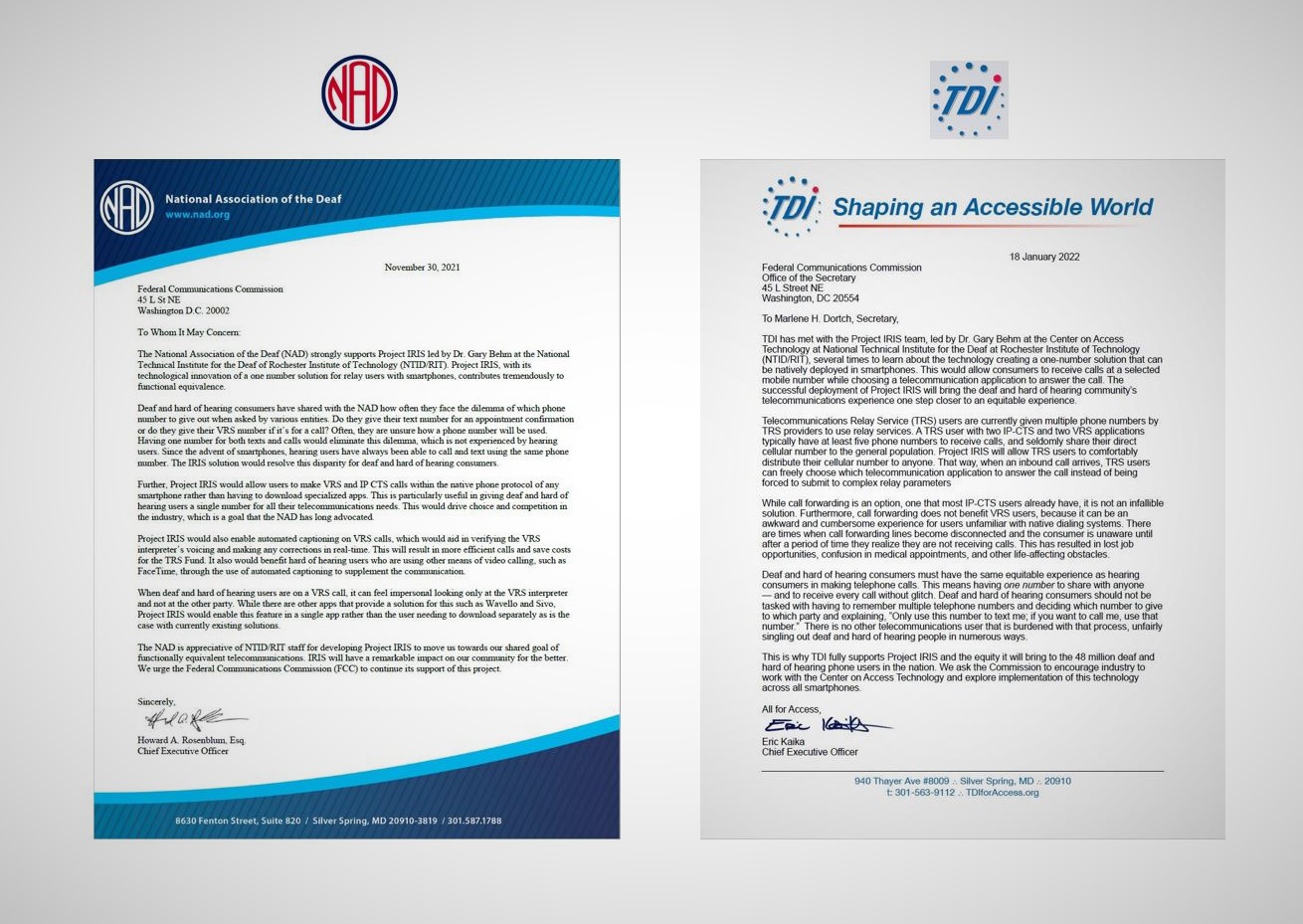
February 2022: The National Association of the Deaf (NAD) and Telecommunications for the Deaf and Hard of Hearing Inc. (TDI) have expressed their full support for the IRIS project led by Dr. Gary Behm and his team in the Center on Access Technology (CAT) at RIT. They acknowledged the limitations of relay services which require multiple phone numbers that can lead to missed calls and miscommunication, and they recognized the need for a single-number phone system that encompasses the communication functions of a smartphone. The letters were sent to the Federal Communication Commission (FCC), encouraging the technology and telecommunication industries to work with the team at CAT to make smartphones even more accessible. The letters are available for you to read: NAD's Letter TDI's Letter.
October 2021: The IRIS team’s demo submission, Equivalent Telecommunications Access on Mobile Devices, was accepted to the ASSETS conference where attendees submit high-quality submissions on the topics of computing and accessibility. They displayed the demo presentation of their R&D work on how to enable Telecommunications Relay Services (TRS) under Accessibility settings on mobile devices to place a video or captioned-based call. The Association for Computing Machinery publication can be found here.
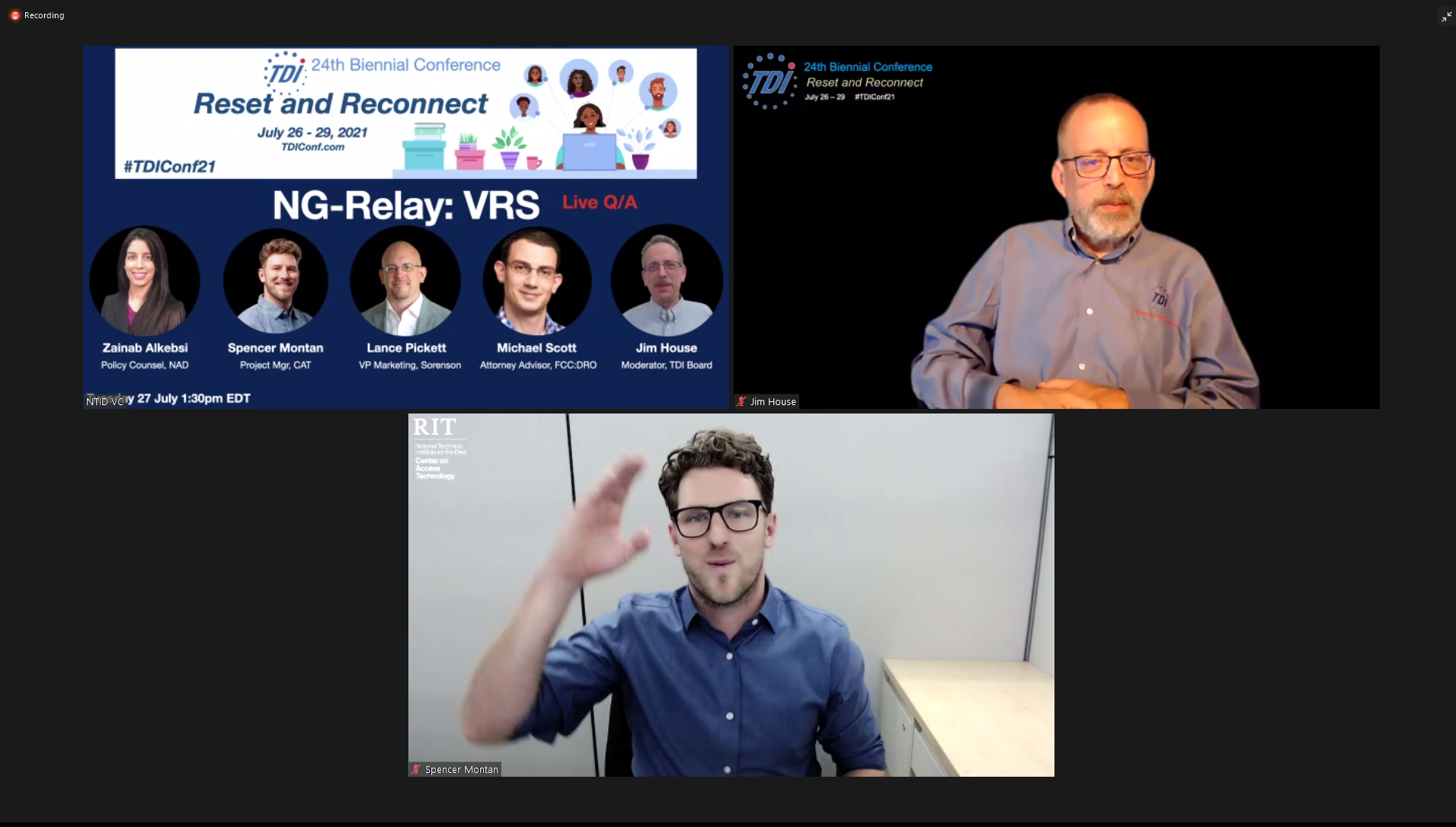
Telecommunications for the Deaf and Hard of Hearing Inc (TDI) 24th Biennial Conference hosted virtually in July, had an ongoing theme: functional equivalence and improved system integration for mobile phones. We are excited that these themes were consistent with the work and vision of IRIS, an effort in making the mobile phone more accessible to TRS services without relying on additional applications. Read more about our reflections on how the TDI conference aligned with the IRIS vision, and what our work ahead will be like here!
Gary Behm, the director of Center on Access Technology and Associate Vice President of Academic Affairs at NTID, was one of the keynote speakers in the Telecommunications for the Deaf and Hard of Hearing Inc (TDI) 24th Biennial Conference that was held virtually at the end of July. In his keynote presentation, Gary spoke about future mobile phone technology possibilities and elaborated more about the IRIS project. It is now available for you to watch to find out what he has to say here!
Our very own CAT team members, Gary Behm and Spencer Montan, will be participating in the Telecommunications for the Deaf and Hard of Hearing Inc (TDI) 24th Biennial Conference at the end of this month. The TDI conference will be held virtually allowing everyone to tune in. Learn more about it here.
While we may have many different ideas of what a perfect mobile phone is like, we can agree that it’s time to improve accessibility. Technology has been changing rapidly, and accessibility on mobile phones is not enough. Now, learn what the possibilities are in improving the accessibility of mobile phone technology. Watch the Series 3 video here.
Are you curious what current technology can do for accessibility on mobile phones? This video looks at improving mobile phone accessibility for the Deaf and hard-of-hearing community. Click here to watch the 2nd series.
It is here! We are excited to release our first video of the IRIS series! Gary Behm, NTID associate vice president of academic affairs, shares his experiences as a Deaf individual and explains the history of accessibility in an ever-evolving technological world. Click here to see the video.
The IRIS research team discovered frustrations among the Deaf and hard of hearing community of mobile phone accessibilities. After engaging of many different ideas, the team explored ways to implement special features of mobile phones. The benefits of having VRS and captioning services native on the phone are at a possible advantage to all users. Learn more about it here.

Technology continues to evolve at a rapid pace, yet accessibility still lags behind. Smartphones have replaced the need for paper maps, flashlights, and even traditional news sources, but how is accessibility keeping pace? Learn more about innovations in accessible smartphone technology and RIT/NTID’s Center on Access Technology’s work on the IRIS project here.
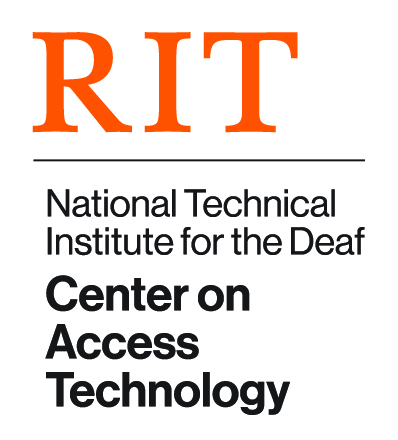
The Center on Access Technology (CAT) is a team formed by student and staff from RIT's National Institute of the Deaf. The mission for the Center on Access Technology is to create and promote technology solutions for the Deaf and Hard of hearing communities. For the past 2 years, CAT has been leading the project IRIS vision. The project was named after on of the Greek goddess of communication. This article begins to describe the history of communication accessibility and CAT's vision for the future. Read more here.
June 2020: IRIS portable prototype that includes an emulated wireless IMS core and emulated Video Relay Service in a single laptop. This allows the IRIS vision to be demonstrated outside a lab environment and can be seen in person to use. This prototype, along with mobile devices (equipped with open-source IMS clients), demonstrates a complete mobile-based 3-party video relay call. To request more information on this prototype, please fill out our form here.
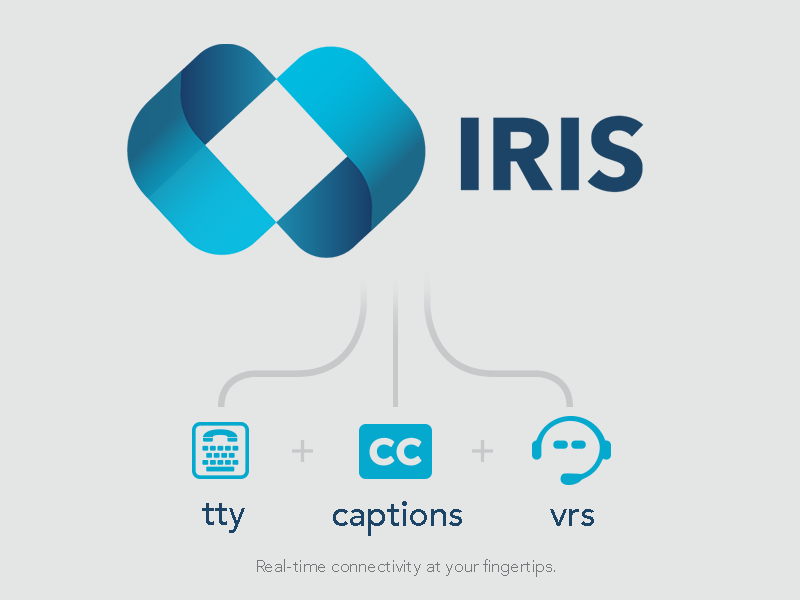
May 2020: The IRIS team provided a presentation about the IRIS vision that may be aligned to the work of the NANC IVC. The North American Numbering Council's Interoperable Video Calling working group is tasked by the Federal Communications Commission to "explore how to facilitate the provision of interoperable telephone number-based video calling." More info on the IVC group can be found here.
February 2020: The IRIS vision was shared with wireless carriers: Sprint, T-Mobile, and Verizon to possibly find collaboration on incorporating the one-number idea for deaf and hard-of-hearing individuals to connect to VRS and Captioning providers through their mobile phone number.
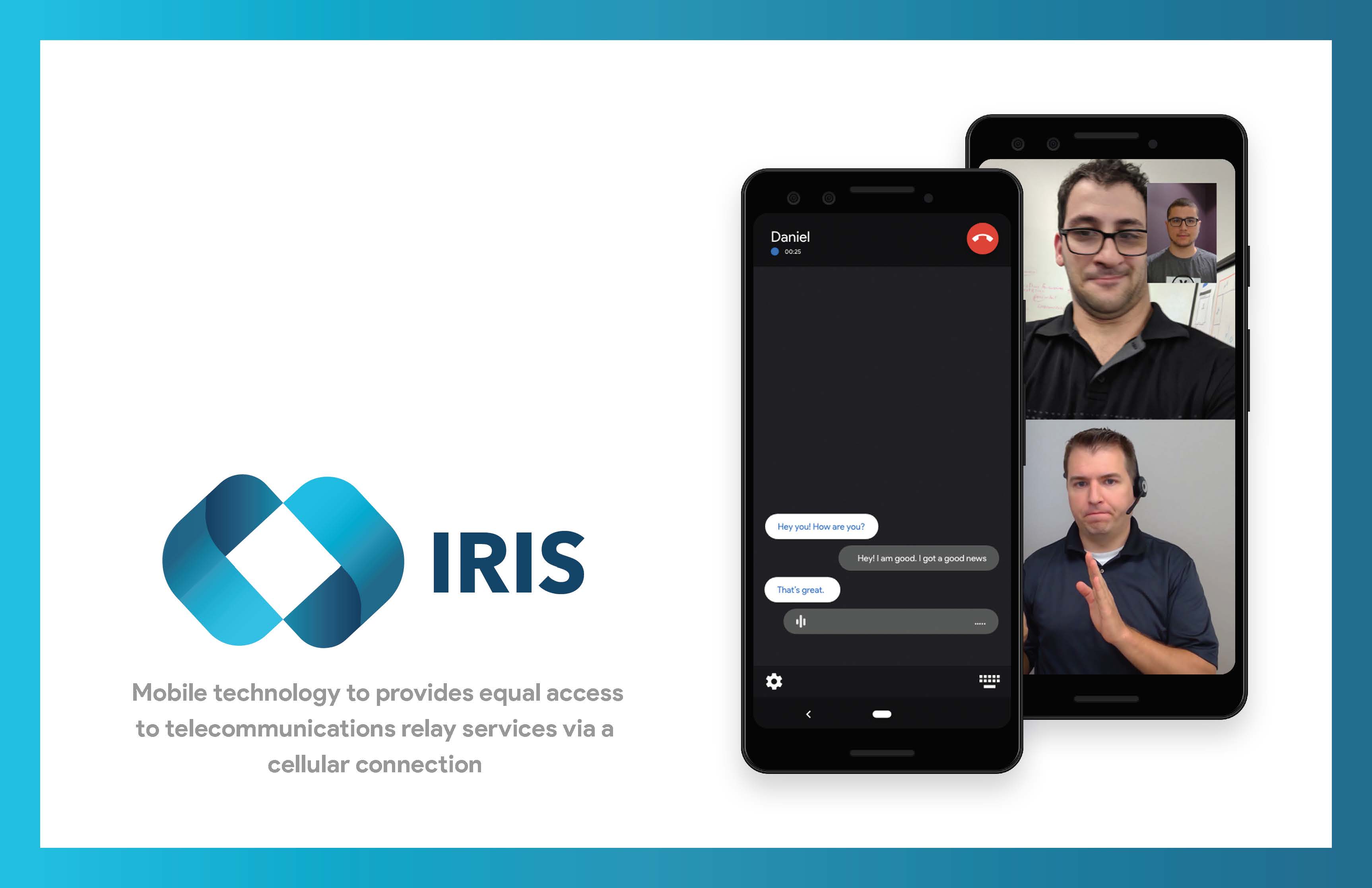
January 2020: The IRIS Vision brochure was developed to share with service providers, community-based organizations, industry partners, and consumers to help capture possible use cases for the IRIS vision. Click here to access our digital brochure.
December 2019: The IRIS team, with the support of the National Association of the Deaf (NAD), Hearing Loss Association of America (HLAA), and Telecommunications for the Deaf Inc. (TDI), met at NAD's office to share the IRIS vision with industry service providers for both Video Relay Service providers as well as Captioned Service providers.
Dec 2019: IRIS IP Multimedia Subsystem (IMS) core prototype with enhanced video relay call functionalities. The network core prototype is developed on top of Kamailio open source IMS, with implementations to support number-based automatic routing to VRS service.
June 2019: IRIS handset prototype on Pixel 3 with enhanced accessibility settings and dialer application software with UI/UX design to support mobile-based video relay call and captioned call.